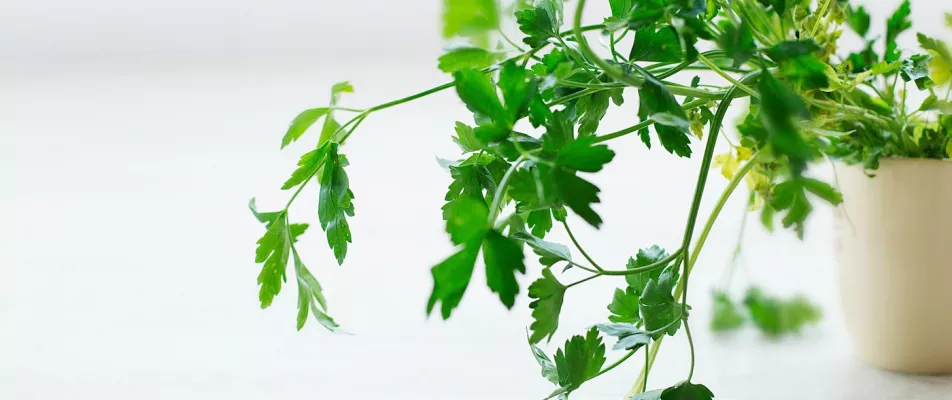
Nutrient Spotlight: Parsley
This springtime staple brings dinner to life. Here’s why we love parsley.
Parsley is a common ingredient found in the supermarket produce section (and usually never runs out). It comes in two varieties: flat leaf and curly, which taste the same. Traditionally used in French and Mediterranean cooking as a spice and herb in fresh or dried forms, parsley brings a delicious fresh, crisp, grassy flavor to spring dishes.
One half cup of chopped parsley provides a TON of nutrition:
- Vitamin A:108% of the Reference Daily Intake (RDI) – big antioxidant and eye health
- Vitamin C:53% of the RDI – big antioxidant and immune health
- Vitamin K:547% of the RDI – blood clotting and bone health
- Antioxidants: Carotenes, lutein and zeaxanthin – big free radicals that help minimize cellular damage
- Folate:11% of the RDI
- Iron: Twice as much as spinach, good sources of calcium and copper as well
Parsley is a digestive aid:
Parsley has a high fiber content and therefore moves things along in the large intestine, helping with indigestion and intestinal gas by calming the system.
Kidney supporter:
Parsley is a natural kidney cleansing herb. It is a diuretic, which helps prevent kidney stones.
Liver protectant:
Parsley is considered a bitter herb. All bitter herbs stimulate the release of bile, which helps the liver detox. Parsley also produces glutathione, which naturally protects the liver from damage. Further, it lowers blood glucose levels, which can irritate the liver if too high and it lowers inflammatory liver enzymes if too high. Parsley binds to and removes heavy metals from the body. It helps out the liver and therefore makes our waste systems to work more efficiently.
Add chopped parsley to everything.
Scrambled eggs, beans, pasta, meats or fish – a bit of parsley will brighten everything up!
Our favorite recipe:
Modified from NYTimes Cooking, Martha Rose Shulman
Lebanese Tabbouleh
¼ cup fine bulgur wheat (I normally sub quinoa because that’s what I have on hand, and it’s gluten-free)
1 small garlic clove, minced
Juice of 2 large lemons, to taste (lots of lemon, makes the recipe)
3 cups chopped fresh flat-leaf parsley (from 3 large bunches)
¼ cup chopped fresh mint
½ pound ripe tomatoes, very finely chopped
1 bunch scallions, finely chopped
Salt, preferably kosher salt, to taste
¼ cup extra virgin olive oil
Step 1
Place the bulgur in a bowl and cover with water by 1/2 inch. Soak for 20 minutes, until slightly softened. Drain through a cheesecloth-lined strainer and press the bulgur against the strainer to squeeze out excess water. If using quinoa, cook on stove according to package directions.
Transfer to a large bowl and toss with the garlic, lemon juice, parsley, mint, tomatoes, scallions and salt. Leave at room temperature or in the refrigerator for two to three hours, so the grain can continue to absorb flavor. No need to do this step if using quinoa.
Step 2
Add the olive oil, toss together, taste and adjust seasonings.
Visit our blog for more seasonal recipes and healthy eating tips. To see if the Healthy Nest Nutrition Natural Weight Loss program is right for you, reach out for a complimentary consultation.
